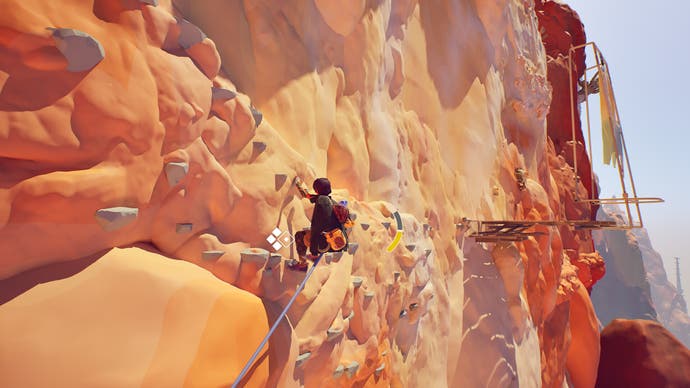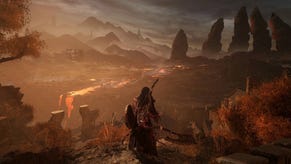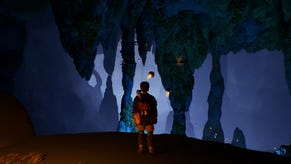Jusant review - soaring design and skyscraping climbs
Topple down headlong.
Oh yes. It was the bit in the movie where you leap from one spar of a broken bridge to another, and try to avoid thinking of the drop beneath you. I buckled up. I checked the carabiner. I decided to trust the line. I leapt. I swung on the rope. And then--
Now. I could have swung across the gap and connected with the other part of the bridge. No problem. In the bold sweep of difficult things that Jusant asks you to do while climbing, this was not actually that tricky - it just looked singularly dramatic. But there I was, suspended on a line above miles of buffeted nothingness, and I saw the bridge and its handholds and the safety and progress it represented. But from this angle I could also see something below me. A cleft in the rock. A lacuna, as my neurologist would say. A gap. And in that gap I glimpsed the outline of a tall building disappearing into shadow, a building that almost seemed made of shadow as much as it was made of rock. My game brain said: optional detail. It said: nice to have. But something else in my brain said: church. Pretty church. Interesting church.
Church, yes - and yet it was so far down, so much of a risk. And that bridge above me with its easy holds... Easy progress...?
It's not important to tell you that I got to the church eventually, or even to tell you about what I found in it. It was indeed optional stuff, nice to have. What's important about this moment was that I wanted to get to that church so much. I needed to. Not because I'm a completionist. I'm not. I wasn't really playing a game by this point, or at least the part of my mind that wanted to get to the church wasn't playing a game. It was so much purer than that. I was compelled to visit this magical half-hidden thing that people had made and that I had glimpsed. I couldn't live with the feeling of having passed it by. I'm not a completionist. This isn't completionism. It's something else. Again and again, Jusant compels me.
Jusant is a climbing game, and I think it's a particularly rich one if you love the idea of climbing, the rarified, oxygen-poor realm of climbing, but haven't done much of the real stuff yourself. If your mind buzzes when you hear jangly, ropy words like "belay" and "carabiner" and "cam", if you thrill to the thought of a climb with a lot of exposure, of a satisfying "problem" to "top out", if you go to sleep whispering names like Bonington or Honnold, this is game for you. It's the game for me.
It's futuristic and fantastical, but only softly so. The world has changed. The water has ceased to fall from the sky and the seas have retreated and left bumpy, arid bed behind them. A silent hero - just a child, really, travelling along with a friendly little pet who rides on their back - approaches a towering piece of rock that stretches up and away into the sky. A mountain, but also the sun-bleached remains of a civilisation that once clung to the mountain, boring inwards to create villages and communal space, and covering the outside with decking, bridges, little huts, mooring points. Lives lived up on the crags.
That's the plot really: the world is dying, so head upwards. It's tinged with the non-denominational mysticism of something like Ico, but when it comes to climbing, which is the heart of the game, it often plays it straight. To play Jusant you have to understand that the left and right triggers stand for your left and right clasping hands, that you travel with a rope attached to a carabiner, that you can place and remove optional pitons for stability, and that the handhelds you use will all be visible on the surfaces you climb. The game isn't faking very much.
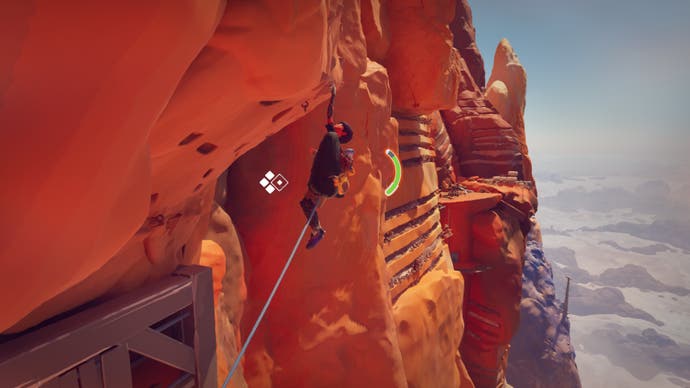
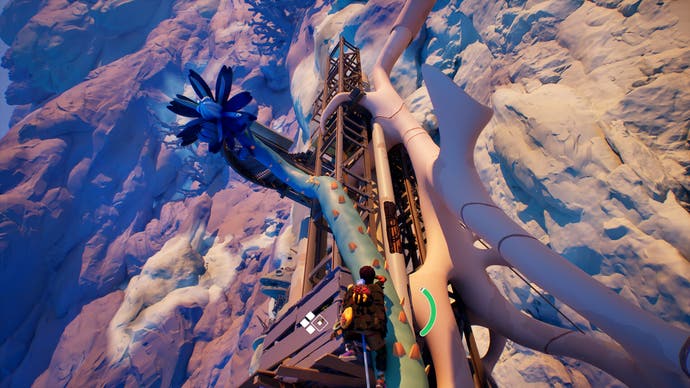
That's the basics, anyway. Early on you learn to climb, to stick in a piton and then use the rope to descend a bit, to swing, to do that cool back-and-forth move that I think might be called a pendulum traversal to reach hard spots. You also learn to read the climbing wall and pick between optional paths. Gaps require jumping, which is beautifully, thrillingly handled here, with the long press and hold of a button as you pull yourself back and then let go. (If that raises alarms for accessibility, I think the team is aware of this, with proper options, outlined below, to follow in a patch at the end of November.) Those pitons, meanwhile, can help if you feel like you're likely to fall, but you can really mess yourself up with them too. You can run out of pitons, or you can place so many that you run out of rope. You can tangle yourself up and trap yourself beneath your own rope. Oh, the things you can do incorrectly here.
Even before the game complicates things, Jusant's climbing is tense and tactical, and it's often about running out of things. Often the thing you're running out of is stamina, which is tracked by a little bar that decreases as you climb, and which can be regained in full by reaching safe ground and stepping away from the wall. In between safe spots, you can rest on the wall and your stamina will fill again, but the longer you spend on the wall the shorter your stamina bar will become, meaning that wall-rests are soon giving you less and less back to play with. Better get to a position where you can stand and regain the whole bar again!
I've made it sound complex, but it actually makes a lot of intuitive sense:if you're in a stress position, even a rest won't get you back to full energy. Jusant reminds me of Dark Souls and its ilk in this way. You know in Souls games the way each life, each flask, is basically a single lens of opportunity that you move over the map? Here, your stamina is a single lens of opportunity you move across the wall, taking time to rest and regain a little, sure, but moving from a firm footing to another - flat ground or a place to buckle onto a new carabiner. It means every chunk of wall feels like a little narrative filled with its own wordless drama. I imagine this is what climbing is like?

And then you get the complications. You can trigger plants to grow, racing up walls and providing new handholds. You can climb using moving handholds, provided by little rock-backed bugs who rove around certain sections of the wall on predictable paths. Later on, you can get a bit of a lift from clouds of glowing jellyfish, and then there are other plants that can be coaxed to create little clusters of buds you can cling to. But the weather! If the sun is too hot, the buds will wither quickly so you have to move. And then there's wind, and... and...
All of this stuff is quite good fun, and at its most mobile, Jusant encourages you to use several different gimmicks on a single piece of wall - climbing on the bugs until you reach a plant, say, then climbing up a tight vertical scar in the rock. But the game is at its purest for me when this stuff is held back a bit and it's just you and the rope and your ability to read the handholds and work out how to proceed. It's telling that towards the very end of the game you get some of the purest climbing, with no gimmicks at all and a new, and entirely unspoken, requirement in terms of understanding how to get the best of your pitons - how to use them to hang and swing, and how to collect them again as you go so you don't run out. It's tense stuff, requiring spatial intelligence and imagination. And it's utterly thrilling.
In between climbing - when you reach a ledge or a former settlement - you get to see another side of Jusant. This is the side that broke the bridge I had to swing across and placed that church down there in a splintered gap of stone. Jusant's world-building is magical, using familiar items like pots and kettles and fishing nets to make a place feel lived in, but also using strange, organic architecture, creating a sense of little Gaudi-like communities that learned to cling to the cliff-face like limpets. Diaries and notes leave behind a sense of who these people were, but the game's actually at its most confident when it's wordless: placing a piece of decking overlooking an abyss, say, with a lone chair sat on it. Recent absence. A feel for beauty, even as the waters recede and survival becomes scrappy.
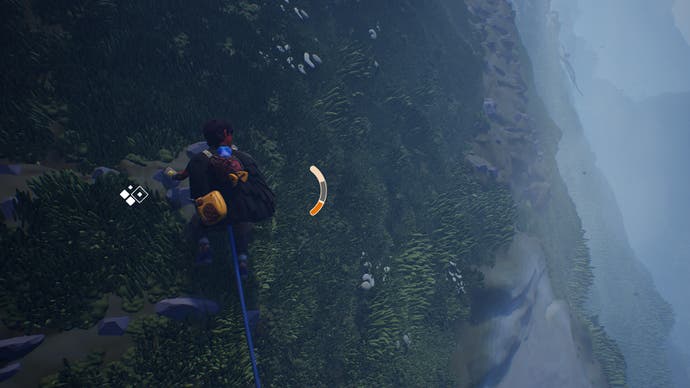
There's range to the game's imagination. For a game about cliffs, Jusant's incredibly good at crafting indoor spaces. A small gap in the wall will lead to a doorway, which will send me down a lengthy corridor, disappearing into darkness. Gaps in masonry will reveal rooms I would love to visit but have to simply witness from a distance for now, while a starkly-rendered hole in the floor shows me a walkway far below which I just know I could stand on if I could work out how to get there. It's the best parts of the old Tomb Raider - silent, studious, giving the player time to make their own connections. And it's often optional. There are story beats and achievements to think about, but really you look for this stuff because it is cool to look for it.
It's not all optional. As the game progresses, you sometimes move from climbing the cliff wall to climbing deep inside these hidden spaces, scaling chimneys of moss one moment and exploring towns built around thick stalactites the next. The wonders in there: the bioluminescent mushrooms and scattering critters! The traversal puzzles as rock wall meets wooden gantries and rusting machinery. And then you're back out into the light again, with your sense of what Jusant is massively expanded.
What a game - a game that renders climbing as a puzzle, sure, but ensures that it's never just a puzzle. Jusant makes sure its climbing still feels tentative, and often trail-blazing. It makes sure it feels like exploration. And as for the rewards? I stopped now and then as I climbed, looking out across a valley, and looking back, perhaps, at the wall I'd just climbed to reach this spot, the terrain I'd just passed through, the path I had needed to construct and fudge and wish into being. At moments like this, I've never had a stronger sense of my living room TV as being a cavity, a cavity in hard rock, into which I can peer in order to find somewhere new and striking and beautiful.
A copy of Jusant was provided for review by Don't Nod.
